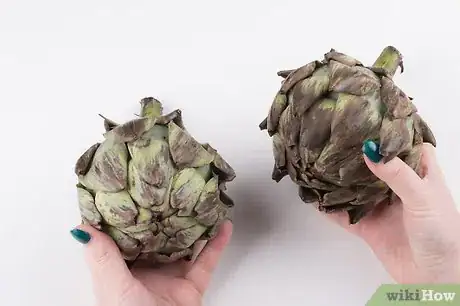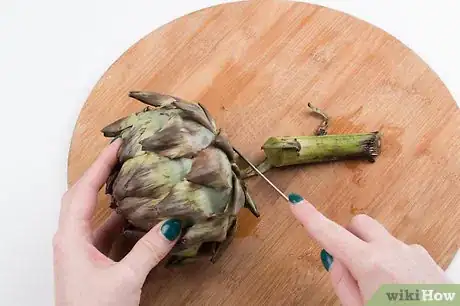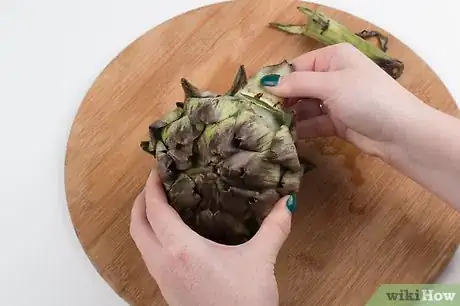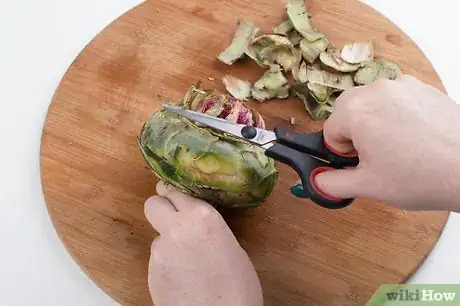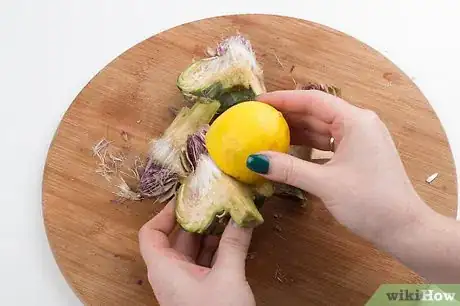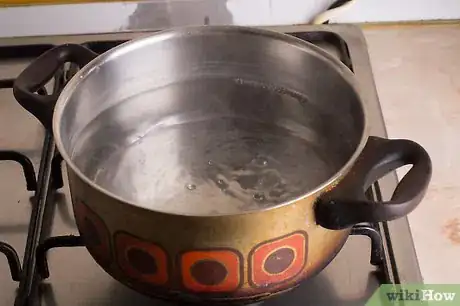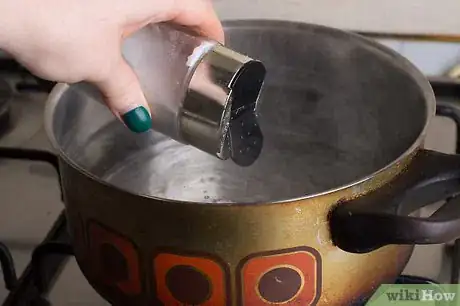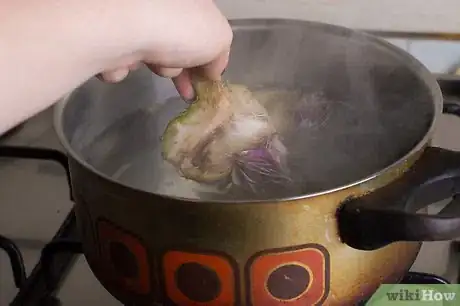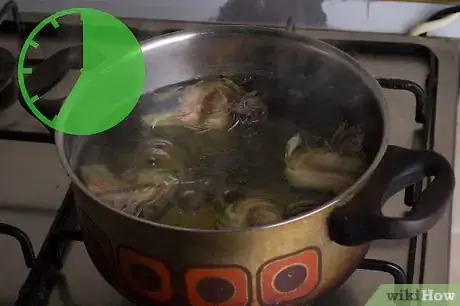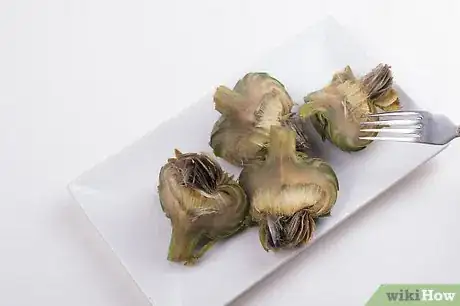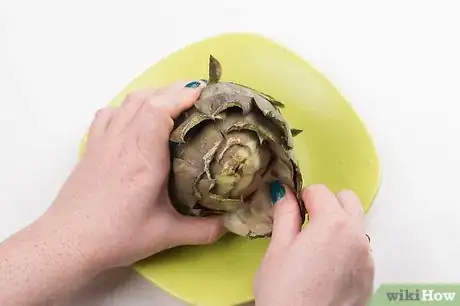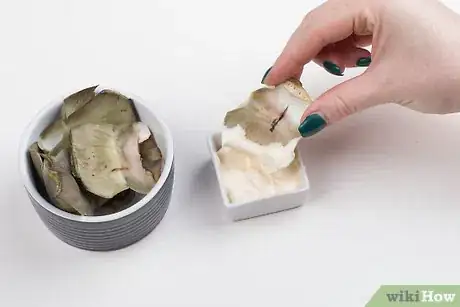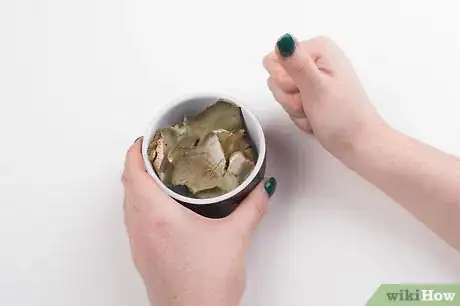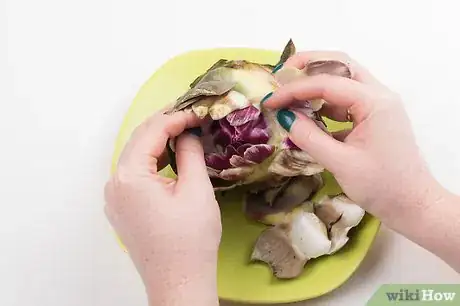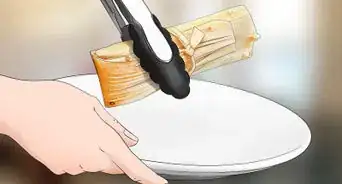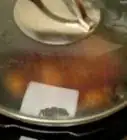wikiHow is a “wiki,” similar to Wikipedia, which means that many of our articles are co-written by multiple authors. To create this article, volunteer authors worked to edit and improve it over time.
This article has been viewed 39,343 times.
Learn more...
Artichokes can seem intimidating if you have never cooked or eaten one, but they are packed with nutrition and flavor. Steam artichokes to preserve as many of the vegetable's nutrients as possible. Steaming can be done on the stove or in a microwave. Here's what you need to know either way.
Ingredients
Makes 2 servings
- 2 large artichokes
- 1 lemon, cut in half
- 1 Tbsp (15 ml) salt
- Water
- Melted butter (optional)
- Mayonnaise (optional)
Steps
Preparing Artichokes
-
1Choose good artichokes. A fresh artichoke will be quite heavy and deep green.
- The artichoke should also have tight leaves that make a squeaking sound when squeezed together. The leaves should not look dry or split apart.[1]
- Smaller artichokes tend to be more tender, but large artichokes have larger hearts, and the hearts are generally the sweetest, most flavorful part of the vegetable.
-
2Wash the artichokes. Rinse well under cool, running water and pat dry with clean paper towels.
- Artichokes tend to hold a considerable amount of dirt and debris inside the tips of the leaves, so you should gently scrub the artichoke with your fingers as you rinse it to dislodge most of the dirt.
- You can also let the artichoke soak briefly in a bowl of cool water for a few minutes before rinsing it, but this is not strictly necessary. Rinsing is usually a sufficient way to clean an artichoke.
- Do not wash artichokes before storing them since doing so could cause them to spoil faster. Wait until immediately before you plan to steam the vegetable.
Advertisement -
3Slice off the stems. Use a sharp knife to cut off all but 1 inch (2.5 cm) of the stem.
- You could cut the stem off completely if you plant to serve the artichokes upright.
- Artichoke stems are edible, but they tend to be bitter, so many people prefer not to eat them.
-
4Remove the outer leaves. Use your fingers to strip the bottom leaves from the artichoke.
- You should be able to remove them with your fingers, but if you have a hard time, cut the leaves away with a knife or scissors.
- You only need to remove the small, fibrous leaves from the very bottom of the artichoke. You do not need to remove the outer leaves along the side.
-
5Cut off the top, if desired. Hold the artichoke on its side with one hand and use your other hand to cut off 1 inch (2.5 cm) of the pointed top with a sharp knife.
- This step is not strictly necessary, but removing the tip can make the artichokes safer and easier to eat.
-
6Trim the remaining leaf tips. Use sharp kitchen scissors to snip off the prickly tips from the remaining outer leaves along the sides.
- The leaves themselves are good to eat, but these prickly portions can scrape your mouth and taste unpleasant.
-
7Treat with lemon. Rub one-half of a cut lemon over all the cut edges of each artichoke.
- Artichokes are prone to oxidation and browning once cut. Acids, like lemon juice, slow the oxidation process long enough for you to cook and serve the artichoke.
Steaming Artichokes on the Stove
-
1Boil water in a deep stockpot. Fill the stockpot with 2 inches (5 cm) or so of water and bring it to a boil on your stove top over high heat.
- The stockpot you use should be large enough to fit a steamer basket.
- As you fill your stockpot with water, keep in mind the water level should fall just below the bottom of your steamer basket once the basket is placed inside the stockpot.
-
2Add lemon juice and salt to the water. Squeeze both halves of the lemon into the boiling water and sprinkle the salt into the water, as well. Let boil for a couple of minutes.
- After adding your lemon juice and salt, rest the steamer basket inside the stockpot. If necessary, add more water to bring the water level to a point just below the steamer basket.
- The lemon juice and salt will both add flavor to the artichokes. Moreover, the additional lemon juice in the water will further help prevent oxidation.
-
3Place the artichokes inside the steamer basket. Situate the artichokes in the steamer basket stem-side-down and keep them in a single layer.
- The artichokes must be in a single layer to cook evenly.
- Cover the stockpot after placing the artichokes inside and reduce the heat to medium-high or medium. The water should still be boiling, but it should not boil violently or splash up through the bottom of the steamer basket.
-
4Cook 25 to 35 minutes.[2] Steam the artichokes until you can pierce the artichoke hearts with the tip of a paring knife and easily pull the inner leaves out with your fingers or a pair of tongs.
- If the water level drops significantly during the cooking process, you might want to consider adding more water to the pot as it boils. Do not remove the lid too often, however, since doing so will release the steam and increase the overall cooking time.
Steaming Artichokes in the Microwave (Alternate Method)
-
1Combine water, lemon juice, and salt in a microwave-safe dish. Add enough water to cover the bottom 1/2 inch (1.25 cm) of the dish. Squeeze the lemon halves into the water and sprinkle with salt. Give the mix a quick stir to combine.
- The lemon juice and salt will help flavor the artichokes. In addition, the extra lemon juice will ward away oxidation.
-
2Add the artichokes to the dish. Dip the stem side of the artichokes in the water first. Then, flip them around so that the top petal side faces down into the water.
- By dunking both ends of the artichoke into the water, you can coat more of the vegetable in the lemon and salt water.
- Placing the artichokes upside-down as you steam them in the microwave will prevent the leaves from collecting water as you cook them.
-
3Cover with plastic wrap. Tightly cover the dish with microwave-safe plastic wrap, creating a good seal capable of trapping the steam inside the dish.
- If you are using a dish with a tight fitting lid, use the lid instead of the plastic wrap. For added precaution, you can use both the plastic wrap and the lid, especially if the lid is fairly loose.
- You need to create a tight seal along the top of the dish to trap enough steam to cook the artichokes.
-
4Microwave for 10 to 13 minutes. Check the artichokes after the first 9 or 10 minutes and cook for an additional minute or so as needed.
- The artichokes are done once you can pierce the artichoke hearts with the tip of a paring knife and easily pull the inner leaves out with your fingers or a pair of tongs.
Eating Steamed Artichokes
-
1Serve while still warm.[3] Artichokes can be eaten warm, at room temperature, or cold, but most people generally prefer to eat them hot and freshly steamed.
- Let the artichokes rest just long enough for them to cool. Otherwise, you may burn your fingertips as you try to enjoy them.
-
2Pull off the outer petals. Use your fingers to peel each outer petal off one at a time.
- The petals or leaves of the artichoke should peel away without much difficulty. If there is any resistance, the artichoke may not have been cooked long enough.
- Peel each petal off by grabbing the tip between your fingers and pulling it down and away from you.
-
3Dip the petals in butter, condiments, or prepared sauce. Melted butter and mayonnaise are two of the most common condiments to serve artichokes with, but the choice of sauce is simply a matter of preference.
- For a simple yet zingy twist, mix a dash of balsamic vinegar into a little mayonnaise and use that for a dipping sauce. (balsamic and mayonnaise)
- When you dunk each petal into the sauce, dip the white, fleshy end in. This is the end that was closest to the center of the artichoke.
-
4Eat the soft portion of the leaf. Grip the other end of the petal and place the dipped side into your mouth. Bite down, slightly, and pull the leaf through your teeth to remove and eat the soft part of the leaf.
- After consuming the soft part of the petal, discard the rest of it.
- Continue peeling and eating the petals in this manner until all the petals have been stripped from the artichoke.
-
5Scrape out the inedible inner fibers. Once the leaves have been removed, use a knife or metal spoon to scrape out the fuzzy "choke," or center, of the artichoke.
- The artichoke heart is hidden beneath the choke.
-
6Remove and eat the heart. Cut the artichoke heart into pieces using a kitchen knife and dip it into melted butter, mayonnaise, or your preferred sauce. Eat the pieces of heart whole.
- This finishes off the artichoke.
Community Q&A
-
QuestionIf I'm using a steamer, how long will this take?
 Hélène FuchsCommunity AnswerThe artichokes should be done in about thirty minutes, depending on their size.
Hélène FuchsCommunity AnswerThe artichokes should be done in about thirty minutes, depending on their size.
Things You'll Need
- Sharp kitchen knife
- Kitchen scissors
- Deep stockpot
- Steamer basket
- Microwave-safe bowl
- Plastic wrap
- Tongs
References
About This Article
Before steaming artichokes, cut off the stems and tops. Next, pull off the outer leaves and trim the tips of the remaining leaves. Then, rub lemon juice onto the artichokes to keep them from browning. After applying lemon juice, place the artichokes in a single layer in a steam basket. Add enough water to a pot to reach just below the steam basket, then heat the water to boiling. Next, place the basket into the boiling water, cover the pot with a lid, and steam the artichokes on medium heat for 25 to 35 minutes. For more tips, including how to steam artichokes in the microwave, keep reading!
